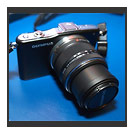 On the eve of Olympus announcing the launch of a new camera in the PEN series, I was given the opportunity to try it out. I and a group of testers were taken behind the scenes at Arthur Ashe Stadium in Flushing Meadows-Corona Park, Queens, NY to put the camera through its paces shooting top-tier professional tennis. I pushed the range of the camera’s capabilities shooting on the roof of the stadium at night, in the workshop of the adept and industrious racquet stringers, and ultimately courtside elbow-to-elbow with other pros managing bozooka-sized zoom lenses on pro-grade dSLRs. Here are my first impressions on how it measured up. The smallest of the Olympus PEN series cameras, the E-PM1, is nicknamed the PEN “Mini,” weighing in at a flyweight 7.65 ounces. It is a pared-down, simpler version of the E-P3, but still retains the most popular aspects of PEN functionality.
On the eve of Olympus announcing the launch of a new camera in the PEN series, I was given the opportunity to try it out. I and a group of testers were taken behind the scenes at Arthur Ashe Stadium in Flushing Meadows-Corona Park, Queens, NY to put the camera through its paces shooting top-tier professional tennis. I pushed the range of the camera’s capabilities shooting on the roof of the stadium at night, in the workshop of the adept and industrious racquet stringers, and ultimately courtside elbow-to-elbow with other pros managing bozooka-sized zoom lenses on pro-grade dSLRs. Here are my first impressions on how it measured up. The smallest of the Olympus PEN series cameras, the E-PM1, is nicknamed the PEN “Mini,” weighing in at a flyweight 7.65 ounces. It is a pared-down, simpler version of the E-P3, but still retains the most popular aspects of PEN functionality.
A rearranged user interface is the most noticeable aspect in the latest micro 4/3rds camera. The icons remain the same, but the menus and how they are used is greatly modified from the rest of the Olympus dSLR family. Six main menu areas are represented vertically on the 3″ 460-dot high-resolution LCD and are selected using the dial. Live Guide takes the guesswork out of what you’re selecting, and provides an immediate explanation of your options. The seven buttons on PEN E-P3 have been streamlined to four on the E-PM1 – Info, Menu, Advance, and one-touch video recording. All other functions have been moved to the dial.
The two menu functions used most are iAuto and Art Filters. iAuto chooses the best mode for your subject, and adjusts exposure and ISO accordingly. Face Detection Auto Focus moves the focus to the subjects eyes for clear snapshots. The ability to customize is not sacrificed, however, and options such as sequential shooting combined with the new FAST (Frequency Acceleration Sensor Technology) Auto Focus system help to get that perfect shot, to varying degrees.
It worked well usually, but in some situations (when there were several people at different distances), it didn’t quite select the faces I wanted it to select. In this instance, the yawning and cell-phone-talking tennis spectators seem to be more in focus than Roddick, the tennis player.
There are several other ways to customize your shots, e.g. playing with your degree of saturation and adjusting monotone, but one particularly cool control is the “Express Motions” selection bar.
By increasing or decreasing the degree on the control bar, you can either shoot with extreme motion trails, or stop motion altogether, as seen in the photos of the hands stringing the racquet. While the stringer’s hands were moving very quickly, fingers and strings are captured with little-to-no motion distortion – a very cool option to have.
Art filters included on the Mini are ultra-saturated Pop Art, sentimental Soft Focus, very hip Grainy Film and Pin Hole, Diorama (like the “tilt-shift” app), and HDR-like Dramatic Tone.
The Manhattan sunset was taken using the pop art filter. Shot in auto, the camera selected ISO 1600, and it’s remarkable for the minimal noise. This mini maxes out at 12,800 ISO and is capable of shooting up to 29 minutes of 1080i HD video with Dolby Digital stereo sound; coolest of all, the art filters can be used while shooting in video mode.
The Olympus E-PM1 is designed to be as easily usable and appealing as a point-and-shoot with its simplified interface and range of colors (purple, pink, brown, white, silver and black.) It serves as an intermediate camera between point-and-shoots and its serious big sister, the E-P3, while taking full advantage of the interchangeable lenses, flash, digital viewfinder, and other peripherals available for the PEN system. It may be too simplified for shooters accustomed to more traditional dSLRs, but is perfect for people who are looking for higher quality images and more lens options than a top-of-the-line point-and-shoot with a built-in-lens, and RAW capability. Available in September 2011, the kit will retail at $499.99 and the PEN E-PM1 body, MSC M.ZUIKO DIGITAL 14-42mm, FL-LM1 Flash, USB cable, video cable, BLS-1 Li-Ion battery pack, Li-Ion battery charger, shoulder strap, OLYMPUS [ib] software CD-ROM, manuals and registration card.
Note: All US Open photographs were shot with the Olympus E-PM1, JPGs straight from the camera – resized only.
Related Content:
All Olympus Camera User Reviews
Olympus Cameras Forum
EVIL & Micro Four Thirds Cameras Forum
More Olympus Camera News And Articles
Olympus Web site


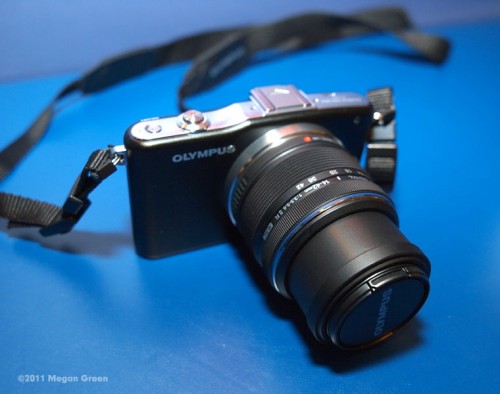
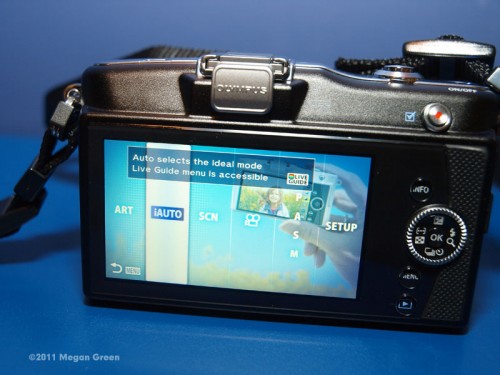
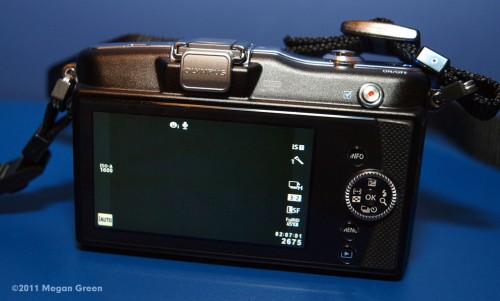

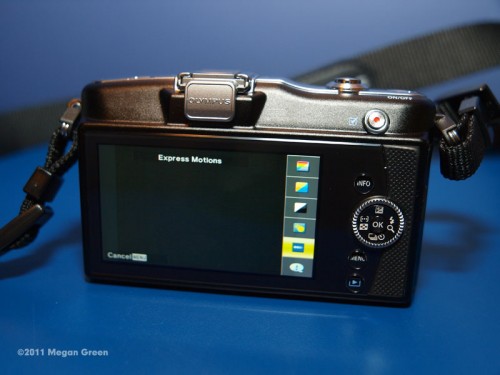
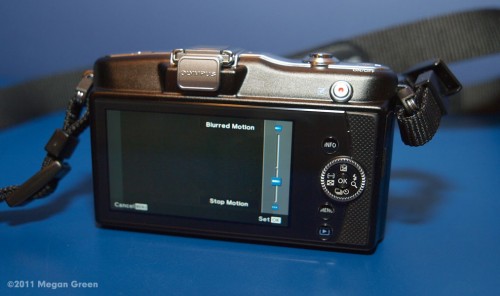
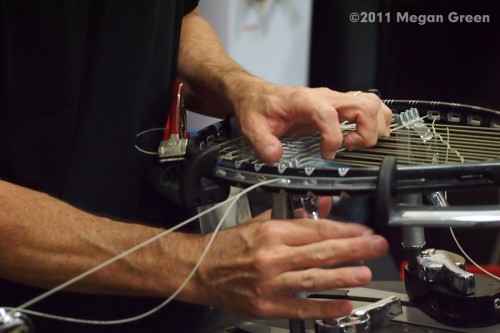
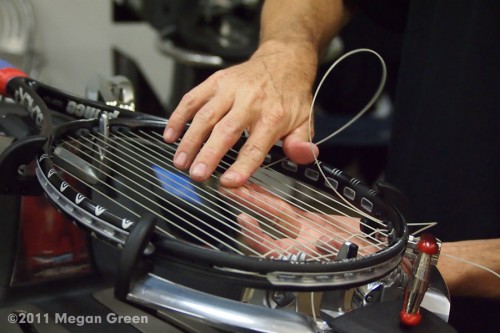
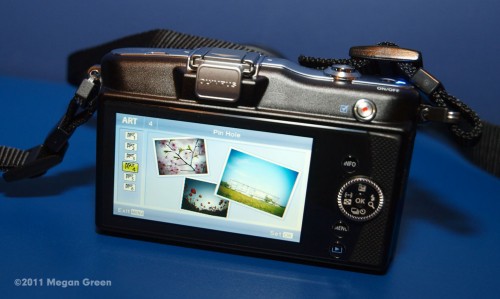

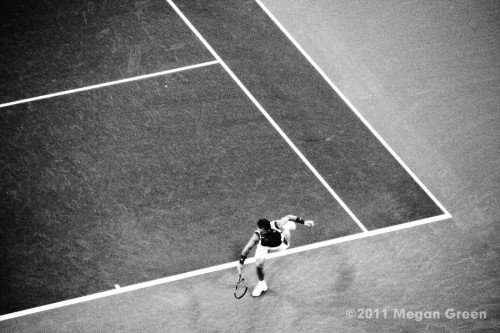

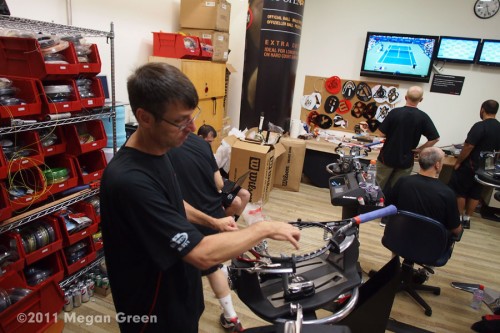

Thanks for the great hands-on intro article, Megan! I don’t see any photos of the E-PM1 in someone’s hand or next to anything that gives me an idea of the size. Can you give us a better idea of how the size compares to the E-P3, E-PL2 or maybe a Canon G12?
Sure, no problem. The E-PM1 dimensions are 4.31″ (W) x 2.50″ (H) x 1.33″ (D) and 7.65 ounces, which is considerably smaller than the EP3 – 4.80in (W) x 2.72in (H) x 1.35in (D), weighing 13.01 ounces (body only on both counts.)
Canon G12 dimensions are 4.41 x 3.00 x 1.90 in. and approximately 12.4 oz.
As a further comparison, my smartphone – the Samsung Epic 4G with a keyboard – is 5.47 ounces and 4.18” x 2.5” x 0.39”.
Thanks for the review.
Since i didn’t see any mention of PASM settings, I conclude that they are not on the camera.
At $499.00 it seems too expensive for a point and shoot and it doesn’t have sufficient features to compete with DSLR type cameras.
None of the images seemed impressive, and with it’s lack of PASM setting this camera won’t be on my shopping list.
It does include PASM settings, sorry I didn’t include that in the review. I only had the camera in my hands for a couple of hours, quickly shooting from location to location within the stadium, and without the benefit of a manual. I didn’t have much of a chance to use those settings, so I reviewed only what I was able to experience.
At $499, it would be very expensive for a point-and-shoot, were it a point-and-shoot. However, the lenses used are the same lenses as the rest of the Olympus PEN system cameras, and are interchangeable like a standard dSLR. Some of the glass available (separately, of course) is pretty high quality. That said, it is not the camera for everyone.
And just as a side note so that it’s out there, the opinions in this review are my own, I tried to be fair and communicate the positives and negatives, and I was not compensated at all by the manufacturer.
Garp-
Megan was in a tough situation with the E-PM1 at the US Open. For reference, here’s a link to a gallery of my Olympus E-P3 photos:
Photo-John’s Olympus E-P3 Photo Gallery >>
One thing about the Olympus Pen cameras, regardless of the camera model, they all share the same basic features and performance. So the E-PM1 has the same sensor as the E-P3 and has the same image quality potential. It’s much smaller than the E-P3 that I used and doesn’t have all the same features. But it’s got a full set of manual exposure controls, the same lens mount and the same 12-megapixel CMOS sensor. I may have had a better lens selection than Megan for my photos. But the E-PM1 could have produced exactly the same quality in the same situations.
If manual controls are important to you, then the E-P3 might be a better choice since it has separate shutter speed and aperture control dials. The E-PM1 and E-PL3 both have one dial and a toggle button for aperture and shutter speed control.
greetings…this is an exceptional camera. treated the way we should a i.c.l. shooter and you can get great clear precise photos(sent some images over to a dslr user,good comments).it appears there are the experts who judge every camera by way of dslr capability, sorry fellows this little baby will test your efforts. it works so much better than any review has stated,stunning,this is my first olympus, the body is top notch quality,finish is superb,handles nicely and it is definately cameraeyecandy, paid $348.00 a.u. at a superstore…best value as well…i am happy…regards…ronald.c.lee-harris.